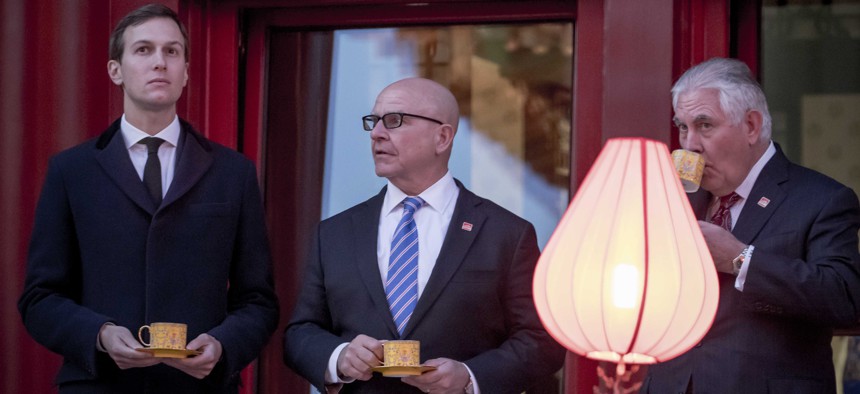
White House Senior Adviser Jared Kushner, National Security Adviser H.R. McMaster, and Secretary of State Rex Tillerson wait for their boss to arrive for a Chinese opera performance at the Forbidden City, Nov. 8, 2017, in Beijing, China. Andrew Harnik/AP
‘Indo-Pacific’ Is the Trump Administration’s New Name for Asia
Why it matters: Chinese media and leaders pay a lot of attention to fine details like this.
The field of international relations is a bountiful source of jargon. There’s “operationalize,” “engagement,” “Thucydides trap,” and so on. Sometimes, though, terms escape the field and make it into the mainstream.
The Trump administration has recently brought one such concept to the wider world: Describing Asia as the “Indo-Pacific,” rather than the “Asia-Pacific.”
All of a sudden, “Indo-Pacific” is appearing from across the administration. The White House schedule for the president’s ongoing trip to Asia used it four times, and didn’t use “Asia-Pacific” once. Rex Tillerson, the secretary of state, mentioned the “Indo-Pacific” over a dozen times in a speech on India given a couple weeks ago. National security advisor H.R. McMaster used it in a briefing given to the press about Trump’s Asia jaunt.
So what’s behind this new way of looking at Asia? Looking at the term’s short history offers a number of clues.
A larger “strategic system”
The term has been has been on the rise in diplomatic and academic circles since the early 2010s, and appears to have been first used by Gurpreet Khurana, an Indian naval officer, in his paper (pdf) on India-Japan cooperation over ocean security. While no American president before Trump has used it, Hillary Clinton mixed it in her lexicon while she was secretary of state. “We understand how important the Indo-Pacific basin is to global trade and commerce,” she said in a 2010 speech in Honolulu, for example. She used it again in a 2011 op-ed in Foreign Policy.
“Indo-Pacific” in its geopolitical sense is relatively new to the world. The main theoretical reasoning behind a switch from “Asia-Pacific” is that it is no longer correct to think about South Asia and East Asia separately. While “Asia-Pacific” conventionally focuses on the area from North Korea to the southern tip of China, “Indo-Pacific” includes countries with coasts on the Indian Ocean, southeast Asia, and Australia, Indonesia, and New Zealand. At the heart of that area are two oceans: the Indian and Pacific. “Indo-Pacific” blurs the division between those bodies of water—in this sense the “Indo-” could mean more “Indian Ocean” and less “India.”
As China’s sphere of influence reaches west into Africa; the economies of India and southeast Asia continue to grow; and India develops its “look east” policy, the area touching these two oceans forms “a single strategic system,” Rory Medcalf, a professor at Australian National University and “Indo-Pacific” advocate, argues in The American Interest. In Shinzo Abe’s 2007 “Confluence of the Two Seas” speech to the Indian parliament, the Japanese president said the two oceans are undergoing a “dynamic coupling as seas of freedom and of prosperity” in a “broader Asia.” A few years later, in a 2013 defense white paper (pdf), the Australian government agreed, writing “A new Indo-Pacific strategic arc is beginning to emerge, connecting the Indian and Pacific Oceans through Southeast Asia.”
Emphasizing India
Another key difference, though, is that the term treats India as a regional power, and not just a big, isolated country. “We talk about Indo-Pacific in part because that phrase captures the importance of India’s rise,” an unnamed White House official explicitly told PTI, an Indian wire service, in Japan over the weekend.
Then there is China. That same White House official also said that the new term is “certainly not” meant to contain China. But for an administration run by Donald Trump—who loves to insult people—it is hard to ignore the possibility that a subtle jab at China might be at least part of the motivation behind the decision. By emphasizing India, “Indo-Pacific” makes China seem relatively less important. In the “Asia-Pacific,” on the other hand, China was clearly the most important actor.
The Chinese media and leadership alike pay a lot of attention to fine details like this. The People’s Daily, the Chinese Communist Party’s mouthpiece, ran a detailed analysis (link in Chinese) with the headline “Don’t say ‘Asia-Pacific,’ say ‘Indo-Pacific’: What Trump is suggesting ahead of his visit to China.” It asks various experts to interpret the shift in terminology. Many gave straightforward answers about the merging of the two oceans, but Chen Yinuo, an “experienced international news journalist,” said that “the core of this concept is simply to weaken China’s influence in the ‘Asia-Pacific'” and to “contain” China’s capabilities at sea.
The Trump administration has not given any explanation for this shift in language, so it remains to be seen whether “Indo-Pacific” suggests any practical difference in Asia policy. (A White House representative promised that Trump would clarify the change at the end of his trip.) One thing that is clear, though, the term doesn’t really offer any new solutions for the biggest question facing Trump’s Asia policy: North Korea.



